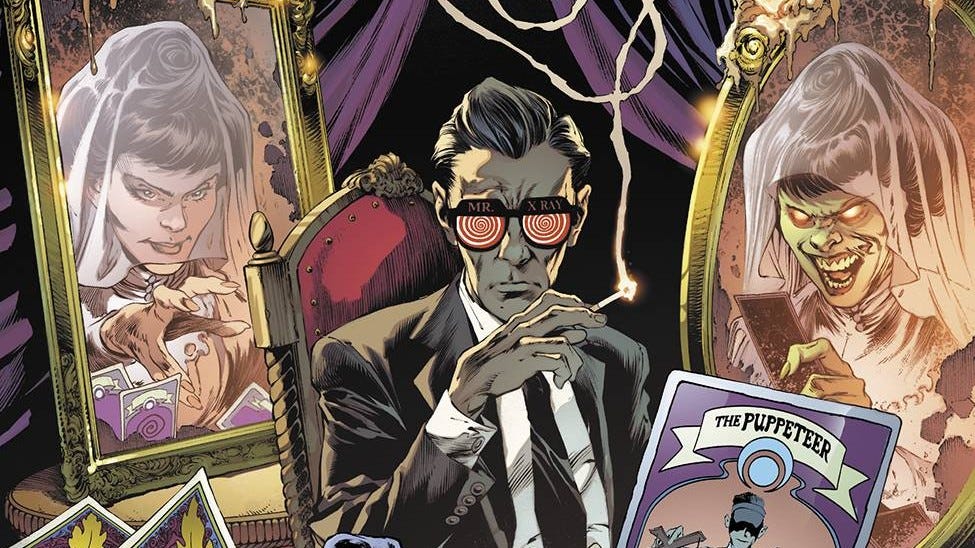Writer: Maytal Zchut
Art: Leila Leiz
Colors: Alex Sinclair
Letters: Rob Leigh
Cover: Leila Leiz w/ Alex Sinclair
Variant Covers: Ivan Reis & Danny Mihi w/ Brad Anderson; Peter Snejbjerg w/ John Halisz; Raymond Gay w/ John Halisz
Publisher: Image Comics
Price: 3.99
Release Date: July 2, 2025
Lifelong friends Sophie and Violet were practically sisters. Now at college, they've been slowly drifting apart. But when Violet accidentally drowns at a sorority hazing, a devastated Sophie pleads with the psychic SISTER HOOD to contact her dead friend. Sometimes you get what you wish for...but on Hyde Street, there's always a cost...and it's a killer.
A Drowning Girl
Billed though it is as “A Hyde Street Story,” Sisterhood #1 is a fully standalone comic. The horror story it sets up, at least for the time being, is accessible by anyone.
Sisterhood #1 begins a horror story, but the supernatural horror elements don’t make their appearance until the final few pages. This is for the best, both for the development of Sophie and VIolet’s relationship, and setting up a little bit of background about the sorority in the wake of Violet’s death. The sorority itself is nothing special. It conforms to the worst stereotypes of Greek life in college.The result is readers will likely be less sympathetic to the sorority or the sorority sisters if something were to happen to them.
Sophie and Violet’s long running friendship is Sisterhood #1’s primary focus. It begins in happiness and perseveres through tragedy before reaching a point that risks it failing. Readers may or may not buy into their friendship reaching that point simply because of Violet joining the sorority. But in any event, the story depends on the reader believing that even though their friendship may have been on the verge of failing, Sophie remained utterly committed to Violet. Zchut spends almost four pages showcasing Sophie being crippled by her grief over Violet’s death.
Violet’s death strikes a strange chord, though. Her dialogue toward Sophie in the scene immediately preceding it borders on completely dismissive. The bragging Violet does when talking to Sophie is bad enough on its own. It becomes almost insulting retroactively when it’s revealed that the sisters think little of her, but despite that, she’s willing to risk her best friend. At the moment of her death, Violet is actually at her least sympathetic. It is possible Zchut connects Violet’s death to alcohol in a callback to Sophie’s mother’s death so as to increase the tragedy of the event. But if so, it’s too subtle to have much effect.
Saving Violet (Or Not)
Leiz’s art does push back on any unsympathetic feelings Violet may have engendered with readers by delivering an appropriately gruesome death. There’s no blood or gore involved. It is a plain drowning. But drowning is already terrifying enough for most people. Violet has a wide smile when the sorority activity begins. That smile seems to remain even through the first panel that shows Violet to be caught under water. Leiz overlaps a smile and exclaimed terror in the panel where Violet is caught in such a way that she looks utterly confused by what’s happening. Her death happens over the course of four panels, ending with her drowned body on a splash page. The eyes rolled up in Violet’s head are a nice touch.
Subtle details, like the rolled up eyes, are where Leiz shines in Sisterhood #1. A half page panel a little before Violet’s death showcases the state of the girls’ dorm room. Violet’s half of the room is somewhat cluttered, but this is not the cliched “one friend is tidy, the other is messy” look. The untidiness is located mainly around the mirror where Violet is obviously getting ready to leave. Indeed, the shoes Violet is wearing on the following page are seen in the half page pane. Thanks to Leiz, the reader can infer that Violet is a bit of a whirlwind, but not a messy disaster. There is no visual indication that the stress on their friendship is anything more than the sorority issue.
The issue’s mood changes immediately following Violet’s death. Sinclair captures that in his coloring by way of all of Sophie’s scenes seeming gray and dark. Certainly Zchut’s script would specify day or night, but in any case, Sinclair is successful at muting various panels in Sophie’s scenes. This works especially well in contrast to the one page that takes place in the sorority house and is very bright.
Leigh makes two noticeable and particularly effective choices with caption boxes in Sisterhood #1. The first is with the third person narration on the issue’s early pages. He uses a canary yellow fill with a red outline. It’s the only time in the issue when a bubble or caption has non-white fill color. Then, late in the issue on a page almost overflowing with text in the form of caption boxes with what unseen characters are saying to Sophie, Leigh places some of the boxes such that their edges are obscured by Sophie. It’s a subtle thing, but it does make it seem like Sophie is in front of the numerous captions and as a result, they feel more organized.
Final Thoughts
Sisterhood’s creative team doesn’t rush its way into the true “horror” story of the series, instead taking almost all of its time building up the players involved. Despite a couple missteps involving Violet, this choice is very successful leading to a shocking final page. Ultimately Sisterhood #1 is an easy to read, standalone beginning to a dark supernatural horror story.
What is good, everybody?
Thanks for reading the review of Image Comics’ Sisterhood #1.
If you enjoyed this review (or even hated it!)…
You can also find me on X and Bluesky where I’m very active.
Republished at Comic Watch.





